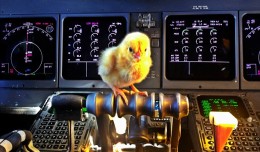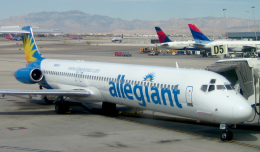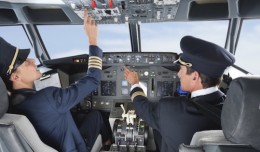Once in awhile, it happens. In 2009, the captain of a Continental Airlines 777 flying from Brussels to Newark passed away during flight. And on September 26 last year, 63 year-old Henry Skillern, captain of a United Airlines flight bound for Seattle suffered a heart attack. In both cases, the first officer — i.e. the copilot — assumed command. The United captain died shortly after an emergency landing in Boise, Idaho.
In both cases, much ado was made of the idea of a copilot having to take over and land on his own. Unfortunately, the press and media — along with most of the flying public — seem to have little grasp of what a copilot’s job actually entails.
As I’ve written multiple times in previous articles, and as discussed in chapter four of my book, copilots are not apprentices. All commercial jets require a minimum of two pilots — a captain and first officer. The latter is known colloquially as the copilot, but both individuals are full-fledged pilots, trained and qualified to operate the aircraft in all phases of flight. The captain is in command and takes home a fatter paycheck, but the hands-on flying duties are shared more or less equally. Copilots perform just as many takeoffs and landings as captains do, in both good and bad weather.
Granted it’s extremely unusual, and perhaps a bit disorienting, for a copilot to find himself alone at the controls. There’s a familiar choreography to a normal, two-pilot operation, and the absence of either pilot will throw off this choreography and substantially increase the workload for the remaining pilot. This is why, rare as such scenarios are, the remaining pilot is likely to ask for assistance from an off-duty colleague in the cabin, or even from a flight attendant. While not a necessity, it’s a good idea to have a second person on hand to help with radio communications, the reading of checklists, or the manipulation of certain switches or controls (deploying the landing gear, setting flaps, etc.). However, while the workload might be higher and the routines out of sync, the tasks themselves, including the landing, are nothing the average copilot hasn’t executed thousands of times in the course of a career.
Be wary of what you see and read. On the heels of the United incident, one prominent media outlet urged calm, reminding readers that copilots, like captains, are in fact “trained pilots.” You don’t say?
It was even worse after the Continental incident in 2009. “That’s what copilots are for,” said an editor at Flight International magazine. “To stand in for the pilot in case of emergency.” Really? It’s possible this comment was taken out of context, but I had never in my life read a more ignorant and misleading characterization of a copilot’s duties and responsibilities.
If I seem unreasonably touchy, maybe that’s because I’m a copilot myself.
At an airline, tenure is everything, and a copilot advances from copilot to captain — we call it “upgrading” — not by virtue of skill or talent, but by virtue of date-of-hire seniority. The seniority system dictates that all pilots be hired initially as copilots, regardless of how much captain time you may have accrued at a past employer. Pilots then submit standing bids for position (captain or first officer), aircraft type and base city. When a captain’s slot opens up somewhere, it is filled by the most senior copilot who has bid for it. Thus that senior copilot now becomes a junior captain.
How long does it typically take to upgrade? It varies tremendously airline to airline, based on company expansion (or contraction), retirement attrition and the subsequent hiring cycles. Such cycles are impossible to predict over the long term: one airline is expanding while another is shrinking; five years down the road it’s the other way around. An upgrade might take three years, five years, fifteen years… who knows. I’m in my 12th year with my employer. It’s a job I love dearly, but I’m not remotely close to holding a captain’s position on any aircraft.
How long it takes also depends on whether or not a pilot wants to accept a captain’s slot right away. A junior captain typically earns more money than a senior copilot, but salary is only one aspect of the job. Because overall quality of life — the base you’re assigned to, the plane you fly, your monthly schedule and so forth — is often better as a top-of-the-list copilot than as a bottom-feeder captain, many copilots will bypass an upgrade until their overall seniority allows for better standing. A choice: would you prefer to be a senior copilot flying 747s to Hong Kong and Rio de Janeiro, with layovers in five-star hotels and 18 days off each month, or a low-rung captain flying 737s on multiple legs each day to places like Kansas City and Nashville, with ten-hour layovers at the airport Holiday Inn? You’ll probably have a better income as the junior captain, but logistically this a much more challenging job — tougher schedules, more time away from home — and not everybody wants it.
I know several pilots who could hold captain positions, but choose not to because of the potential impact on their lifestyle and schedules. And thus it’s not terribly unusual for a copilot to be older and more experienced than the captain sitting next to him.
Where you won’t find a lot of bypassing, however, is at the regional carriers — those myriad “express” and “connection” contractors that fly on behalf of the majors. Copilot wages tend to be ridiculously low at these companies, and upgrades are coveted. Plus, having captain’s time on your resume is very valuable when it comes time to applying at a major. (And if you get hired, it’s back to being a junior copilot again, albeit at substantially better pay than any regional has to offer.)
Copilots are the ones with three stripes on their cuffs and epaulets. Captains wear four. In the cockpit, the copilot sits in the right seat; the captain on the left.
Long-haul flights carry augmented crews that work in shifts. You might see a captain and two first officers, a captain and three first officers, or two captains and two first officers. It differs airline to airline, as well as with the length of flight. Throw in a line check or other training exercise, and there can be as many as five pilots on the flight deck, in any combination of rank.
This article was originally published on AskThePilot.com and is used here with the author’s permission. Patrick Smith is an airline pilot, air travel columnist and author behind the site AskThePilot.com. In his spare time he has visited more than 70 countries and always asks for a window seat. He lives in Somerville, Massachusetts.







